Chapter 468-18 WAC
Last Update: 4/14/09CITY/COUNTY PROJECT COORDINATION
WAC Sections
| HTMLPDF | 468-18-010 | Consent by local governing body. |
| HTMLPDF | 468-18-030 | Policy governing use of county roads as haul roads on state highway projects. |
| HTMLPDF | 468-18-040 | Design standards for rearranged county roads, frontage roads, access roads, intersections, ramps and crossings. |
| HTMLPDF | 468-18-050 | Policy on the construction, improvement and maintenance of intersections of state highways and city streets. |
DISPOSITION OF SECTIONS FORMERLY CODIFIED IN THIS TITLE
| 468-18-060 | Secretary of transportation to proceed with hearings under the Federal Aid Highway Act of 1956. [Statutory Authority: 1977 ex.s. c 151. WSR 79-01-033 (DOT Order 10 and Comm. Order 1, Resolution No. 13), § 468-18-060, filed 12/20/78. Formerly WAC 252-10-105.] Repealed by WSR 99-01-121 (Order 186), filed 12/21/98, effective 1/21/99. Statutory Authority: RCW 47.01.101. |
| 468-18-070 | Federal aid urban funds. [Statutory Authority: 1977 ex.s. c 151. WSR 79-01-033 (DOT Order 10 and Comm. Order 1, Resolution No. 13), § 468-18-070, filed 12/20/78. Formerly WAC 252-10-110.] Repealed by WSR 81-15-060 (Order 63), filed 7/20/81. Statutory Authority: RCW 47.04.060. |
| 468-18-080 | Policy governing the application of federal aid secondary funds. [Statutory Authority: RCW 47.01.071. WSR 83-13-099 (Order 38, Resolution No. 192), § 468-18-080, filed 6/21/83. Statutory Authority: 1977 ex.s. c 151. WSR 79-01-033 (DOT Order 10 and Comm. Order 1, Resolution No. 13), § 468-18-080, filed 12/20/78. Formerly WAC 252-10-120.] Repealed by WSR 99-01-121 (Order 186), filed 12/21/98, effective 1/21/99. Statutory Authority: RCW 47.01.101. |
| 468-18-090 | Matching of urban arterial trust account moneys. [Statutory Authority: RCW 47.01.071. WSR 85-15-080 (Order 48, Resolution No. 246), § 468-18-090, filed 7/22/85. Statutory Authority: 1977 ex.s. c 151. WSR 79-01-033 (DOT Order 10 and Comm. Order 1, Resolution No. 13), § 468-18-090, filed 12/20/78. Formerly WAC 252-10-130.] Repealed by WSR 91-02-006 (Order 125), filed 12/21/90, effective 1/21/91. Statutory Authority: Chapter 47.26 RCW. |
PDF468-18-010
Consent by local governing body.
Consent by local governing body . . . it is the requirement of the state department of transportation that when consent or concurrence is required of any local governing body as to any project or proposal of the state department of transportation, the local body indicate its concurrence, assent or other action regarding such project or proposal by resolution of the governing body of such authority, duly passed at a regular meeting of such body and directed to be transmitted to the state department of transportation.
[Statutory Authority: 1977 ex.s. c 151. WSR 79-01-033 (DOT Order 10 and Comm. Order 1, Resolution No. 13), § 468-18-010, filed 12/20/78. Formerly WAC 252-10-010.]
PDF468-18-030
Policy governing use of county roads as haul roads on state highway projects.
(1) The secretary of transportation or his representative shall, at the time of the preliminary planning for any state highway project requiring the use of any county road or portion thereof as a haul road, contact the county officials and advise them that such use is contemplated.
(2) When the final plans for such project are prepared, and prior to advertising for bids, the secretary of transportation or his representative shall meet with the county officials and inform them of the full particulars regarding the intended use of the county road, including estimates of the total yardage involved and the duration of the project.
(3) Before a contract is awarded, the secretary of transportation and the county officials shall sign an agreement setting forth clearly the obligations of the state for defraying added maintenance costs for the county road involved. The agreement shall specifically set forth that the conclusions of the secretary of transportation as to the actual costs to be paid by the state shall be final and conclusive.
(4) Subsequent to the state's contractor having terminated his use of the county road and as soon thereafter as is possible the county shall submit its claim for compensation for additional maintenance and the secretary shall make such review thereof as shall be necessary to ascertain that the state will pay only that portion of the increased maintenance costs occasioned by the state's contractor's use of the county roads.
(5) A special provision in the contract shall specify that the contractor or contractors using the county road as a haul road in connection with the state project shall abide by all weight and speed laws in the operation of his or their equipment and shall be liable for any increased damage to the road by reason of his or their failure to do so.
(6) For administration purposes moneys paid pursuant to the maintenance agreement shall be included as part of the construction project.
[Statutory Authority: 1977 ex.s. c 151. WSR 79-01-033 (DOT Order 10 and Comm. Order 1, Resolution No. 13), § 468-18-030, filed 12/20/78. Formerly WAC 252-10-030.]
PDF468-18-040
Design standards for rearranged county roads, frontage roads, access roads, intersections, ramps and crossings.
Because of the wide variety of rearranged county roads, frontage or access roads, intersections, ramps and crossings encountered by the freeway construction and relocation of other state highways, further understandings are desirable as to the jurisdiction and the responsibility between the county and state.
Following are the criteria, procedure and design standards that the state department of transportation shall use in the planning for frontage roads and access roads that counties will be requested to accept as county roads and the construction of rearranged county roads, intersections, ramps and crossings:
(1) At the early stages of planning, the state and county shall review the proposed improvement and determine what cooperative agreements will be needed between the state and county.
(2) The proposed design standards shall not be less than the current "city-county design standards" located within the "Local Agency Guideline Manual," except where an individual county shall have adopted a higher design standard, in which case the higher standard shall apply.
(3) The proposed construction shall include all the necessary traffic control and safety devices and be signed in accordance with the Manual on Uniform Traffic Control Devices for Streets and Highways, as modified and adopted by the Washington state department of transportation, to protect the driving public.
(4) Unless otherwise agreed to between the state and county, the responsibilities of each agency shall conform to the following basic principles:
(a) Where an existing county road is crossed by a state highway underpass, the state will construct the underpass and necessary approaches and maintain the underpass.
The roadway to be provided for county traffic will be constructed by the state.
If illumination exists on the county road at the time of construction of the underpass, the state shall provide the necessary facilities for illuminating the county's portion of the road over the state highway and the necessary approach roadway.
If it is determined that illumination will be necessary at a later date and it will be necessary to place conduits in the structure, the state shall provide same.
The county will maintain the roadway providing for county traffic including traffic stripe, snow removal, sanding and illumination, if needed, for the county road.
(b) Where an existing county road is crossed by a state highway overpass, the state will construct the structure and necessary approach roadway and maintain the structure.
The county will maintain the entire roadway under the structure except special drainage, if needed.
The state shall provide the necessary facilities for illuminating the county's portion of the road under the structure and necessary approach roadway, unless otherwise agreed.
(c) When an existing county road is crossed at grade by a new state highway, the state will assume all costs for the construction including taper sections, acceleration and deceleration lanes and be responsible for all maintenance to the right of way line.
Stop signs after installation shall be maintained in accordance with the state statutes.
The construction and maintenance of illumination will be the responsibility of the state.
When a new county road intersects a state highway, the maintenance responsibilities will be the same as outlined above. The construction costs shall be the responsibility of the county.
(d) Whenever, because of increased traffic, heavy turning movements, accident frequency or other good cause, it becomes necessary to initiate a project for the improvement of an existing intersection not incidental to a construction project, the state and county will cooperate in the cost of the improvement in each case by mutual agreement in accordance with the following formula:
(i) Ascertain the number of legs of the intersection under the existing responsibility of each agency involved.
(ii) Ascertain the traffic volume on each leg.
(iii) Add the traffic counts on each agency's intersection legs.
(iv) The resulting percentage of the traffic volume total falling to each jurisdiction should be the relative proportion of the improvement's cost to be borne by each agency: Provided, That in no case shall the county's share of the total cost of the improvement exceed fifty percent of that cost.
The maintenance responsibilities will be the same as outlined above in subparagraph (c) of this subsection.
(e) When an interchange is constructed at an intersection of a state highway and county road, the ramps, structure and crossroad within the interchange area shall be maintained and reconstructed, if necessary, by the state. Illumination, if required, shall be constructed by the state and that portion located on state right of way maintained by the state or as otherwise agreed.
Traffic signals on state right of way, if required at ramp terminals, shall be constructed, operated and maintained by the state.
(f) Where it is necessary to relocate an existing county road, the state will construct the road and the county will maintain the road.
(g) If a county road or street is dead-ended, the state will construct a cul-de-sac to the county standards.
(h) When it is necessary for the state to construct service roads, landlock prevention roads or dead-end roads, which may be desirable in lieu of damages to property, the provisions of RCW 47.52.105 shall be the guide.
All roads under this subsection shall be the state's responsibility unless otherwise agreed to between the state and county.
(i) Upon completion of the construction of each rearranged county road, frontage road, access road, intersection or crossing for which an agreement has been entered into between the state and county, an inspection by the state and county road engineer shall be made to determine that all the requirements of the agreement have been fulfilled. Upon fulfillment of the agreement, the state shall notify the county in writing and the county shall assume the responsibilities as set forth in said agreement.
(5) The transfer of any right of way by the state to a county for any rearranged county road, frontage road, access road, intersection, crossing, or improvements constructed under this chapter shall be in accordance with WAC 468-30-070, as amended.
[Statutory Authority: RCW 36.75.090. WSR 09-09-068, § 468-18-040, filed 4/14/09, effective 5/15/09. Statutory Authority: RCW 47.01.101. WSR 99-01-121 (Order 186), § 468-18-040, filed 12/21/98, effective 1/21/99. Statutory Authority: 1977 ex.s. c 151. WSR 79-01-033 (DOT Order 10 and Comm. Order 1, Resolution No. 13), § 468-18-040, filed 12/20/78. Formerly WAC 252-10-041.]
PDF468-18-050
Policy on the construction, improvement and maintenance of intersections of state highways and city streets.
(1) Legal reference. Section 61, chapter 220, Laws of 1949 provides in part as follows: "...; and all such streets including curbs and gutters and street intersections and such bridges and wharves shall be constructed and maintained by the director from any state funds available therefor.
"The jurisdiction control and duty of the state and city and town with respect to said streets shall be as follows:
"(a)...
"(b) The city and town shall exercise full responsibility for and control over any such street beyond the curbs, and if no curb is installed beyond the portion used for highway purposes."
(2) The problem. The construction of partially and fully controlled limited access freeways or similarly designed state highways through cities and towns is becoming more frequent. The construction of cloverleaf and other types of interchanges makes it difficult to determine exactly which features of the interchange constitute the "street intersection" for which responsibility is established by law.
(3) The policy. After the access plan for any partial, or fully controlled limited access highway has been approved by a city or town, the state and city authorities shall negotiate an agreement establishing responsibility for construction and maintenance of the various features of each interchange. To illustrate the basic principles of these responsibilities and to serve as a guide in such negotiations, the attached sketches of typical intersections and interchanges are hereby made a part of this policy. The scope of this policy does not include the roadside areas enclosed in the loops or ramps of an interchange or the slopes of cuts and fills, responsibility for which is more clearly defined by statute.
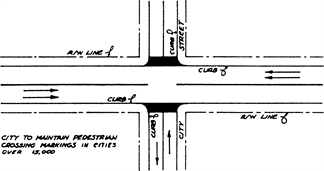 |
normal intersection existing state highway state maintenance obligation shown in green Figure 1 |
 |
existing city street crossed by new state highway underpass city maintenance obligation shown in red Figure 2 |
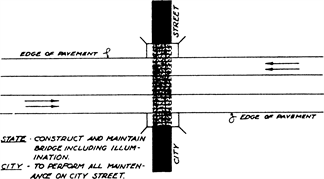 |
existing city street crossed by new state highway overpass city maintenance obligation shown in red Figure 3 |
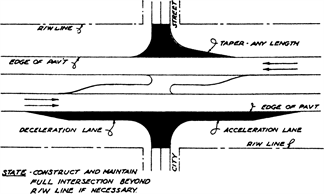 |
existing city street crossed at grade by new state highway state maintenance obligation shown in green Figure 4 |
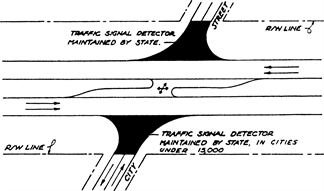 |
channelized intersection new state highway state maintenance obligation shown in green Figure 5 |
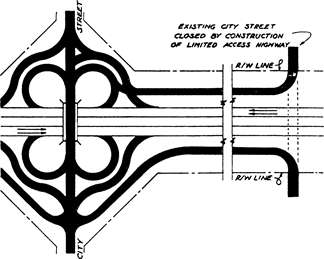 |
typical limited access highway city maintenance obligation shown in red state maintenance obligation shown in green Figure 6 |
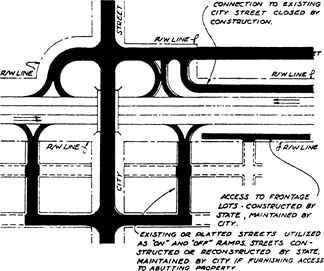 |
typical limited access highway utilizing city streets as "on" and "off" ramps city maintenance obligation shown in red state maintenance obligation shown in green Figure 7 |
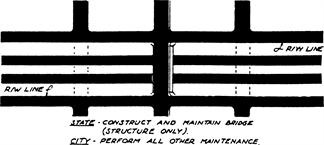 |
depressed limited access highway located between city streets city maintenance obligation shown in red state maintenance obligation shown in green Figure 8 |
On April 30, 1997, the department of transportation and the Association of Washington Cities approved guidelines on the interpretation of selected topics of chapter 47.24 RCW and the above figures for the construction, operation and maintenance responsibilities of the department and cities for city streets that are part of state highways. These guidelines are general in nature and do not preclude the department and individual cities from entering into agreements to address particular circumstances.
[Statutory Authority: RCW 47.01.101. WSR 99-01-121 (Order 186), § 468-18-050, filed 12/21/98, effective 1/21/99. Statutory Authority: 1977 ex.s. c 151. WSR 79-01-033 (DOT Order 10 and Comm. Order 1, Resolution No. 13), § 468-18-050, filed 12/20/78. Formerly WAC 252-10-050.]